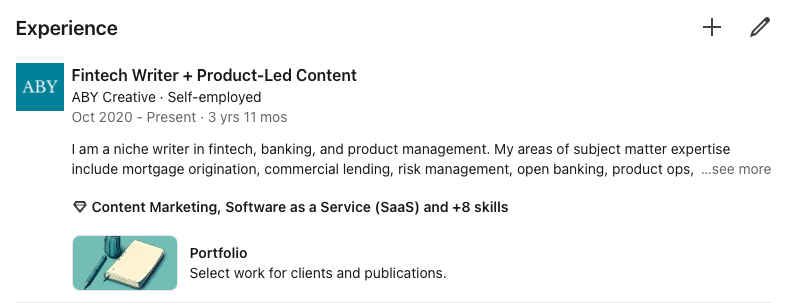One Freelancer’s Journey: From Cheap Projects to Niche Expert
A peek behind the scenes of a thriving freelance writing business.

When I first began freelancing, almost three years ago, I was paid $27 for 1,000 words. I didn’t know any better and thought that writing was simply a low-paid career path, a misconception I’d graduated from college with an English degree. Instead of pursuing writing, I went to work for a tech.
Fast forward more than a decade, and I’ve come full circle. I’m a full-time freelance writer. I charge around $1/word and most of my work is inbound.
A lot of people claim that freelancing earns them six figures per year, but don’t share the details of how they got there. You have no idea how well-connected they are, how many hours they worked, and how much they were earning when they started. It’s rare that there’s a “quick path” to a successful freelance business.
I write this for transparency so that other freelancers can know the exact steps of one freelancer’s journey.
Building a portfolio in the early days
I first began freelancing for less than three cents per word because I wanted to pivot from working at a software company to content marketing.
I wasn’t looking to freelance long-term: I wanted a full-time job. And I realized very quickly that no one would hire me without a portfolio. I found a content mill that was willing to hire me as a freelance writer and got to work (alongside my 9–5 tech job).
I knew nothing about content marketing but the agency gave me a checklist of things to do for each article. There was a giant queue of work and I could select what I wanted to write about. I stuck to topics I knew well, based on my work experiences in tech. But I also ended up writing about dentistry, selling a home, and screen time for kids.
It is extremely hard for a freelancer to find work without a portfolio. It showcases your expertise and the quality of your work to potential clients. So while I very much believe that companies should pay their writers well, I also look at this beginning period as necessary because I don’t know how else I would have established a portfolio.
Agency life and finding my first clients
After about three months of writing for the trash agency and tens of thousands of words written, I was able to land a full-time job as a content marketer. The salary was really low compared to what I’d been earning in tech, but I knew I was seen as an “inexperienced” writer.
I made an announcement on LinkedIn that I was leaving tech. In that transition time, I landed two clients. Both came to me via my connections in the tech world. That’s something freelancers don’t talk about enough: a network is everything. It means referrals, introductions, and an easier time finding clients.
I was offered an ongoing role at a magazine for 50 cents per word (I nearly fell out of my chair when this was offered to me) and began writing blog posts for tech companies at 25 cents per word.
I did this freelance work while also working at my shiny, new full-time job. I needed the money, to make up part of the difference in salary. But also, the magazine work was bylined: another critical element for my portfolio.
Because I now had my own clients, I got serious about my freelance business. I began using an invoicing tool (Quickbooks Self-Employed) and a project management tool (Trello). I also overhauled my website so it looked more professional.

More experience and raising my rates
I was very fortunate that my agency job was with a lot of high-end clients. As I learned more about content marketing and my work was published, I gained some blue-chip brands in my portfolio.
I also found out that the agency was charging clients more than $2,200 per blog post (another “fall out of my chair” moment). And the agency had a waitlist of clients. I realized that certain companies were willing to pay a lot for high-quality writing.
I also joined a writing community. The group encouraged me to charge more, to “charge what you’re worth.” They shared openly about what they were charging clients.
I was shaking the first time I quoted a client 65 cents per word. The client said yes. Then I asked for 75 cents per word, and it was also accepted. This was about a year after I first began freelancing. I only had a few clients of my own, delivering one freelance blog post per week in addition to my agency work.
Transition to a full-time freelancer
Two years after I pivoted from tech to content marketing and journalism, I began freelancing full-time. It was something I’d been contemplating for a while but the timing was not my decision. I had an acrimonious end to my full-time job. I needed money and figured I could ramp up freelancing more quickly than finding a new job.
Ever since I made the transition from tech, I have focused on building my professional network on LinkedIn. When I decided to plunge into full-time freelancing, my network paid off. Within about two months, I had a full roster of clients, all paying around 75 cents per word.
I meticulously maintain my portfolio, tracking when clients publish my work. I positioned myself as a niche expert based on my prior tech experience, something that set me apart from other freelancers.
I also added more tools to my tech stack, like Calendly for scheduling, Airtable for client management, and Buffer for social media management. I was happy to pay for any tools that made my freelance life easier and made me appear more professional to clients.
I continued to raise my rates because I was getting so many “yeses” whenever I sent a proposal to clients. Now, I charge anywhere from 75 cents per word to $1.25 per word, based on the scope of the project.
These rates are entirely due to the strength of my portfolio. Potential clients know what they can expect from me. I also routinely ask clients for testimonials (added both to my LinkedIn profile and my website).
A business of inbound work
The current stage of my freelance work is that most of my business is inbound. While some of this work is via referral, a lot of it comes from LinkedIn.
This isn’t without effort on my part. I maintain a social presence by publishing regularly on LinkedIn and connecting with marketers and journalists in my niche.
I occasionally write about freelancing or topics related to my expertise. But mostly, I post about anything I find interesting. The goal is only to show up in the feed, and get potential clients to “see” me so they peek at my profile and portfolio. I let my LinkedIn headline do the work: I describe myself as a “Freelance Fintech Writer + Product-Led Content.”

I want clients to want to work with me. Part of my posting strategy is to show personality.
I also have a LinkedIn Company Page. This is so my freelance business shows up in my experience:

And my Company Page shows up in LinkedIn searches every week, sometimes thousands of searches. I post to it very rarely, but enough to keep the page active. It’s one more avenue for clients to find me.
What’s next in freelance life?
For now, I’m fine with maintaining my business as-is. I take on new clients as I have availability and part ways with clients that aren’t a good fit. I’m in that six-figure freelancer category, with a mostly-stable monthly income, even though most of my work for clients is ad hoc.
I have plenty of time during the week for my own creative pursuits, such as writing on Medium and in my Substack.
Even though I’ve pushed the envelope with pricing, I’m also cautious. The tech industry I write in has been ravaged by layoffs and I’ve heard that some freelancers have struggled to find work. So I’m perfectly happy with the work I have, even though I have plans (someday) to narrow even further into work I care about.
Portfolio. Niche. Network. Three critical ingredients for a successful freelance business. None of which will happen overnight.
Check out my free eBook: 17 Smart Tools Solopreneurs Need to Start, Grow, and Scale.






